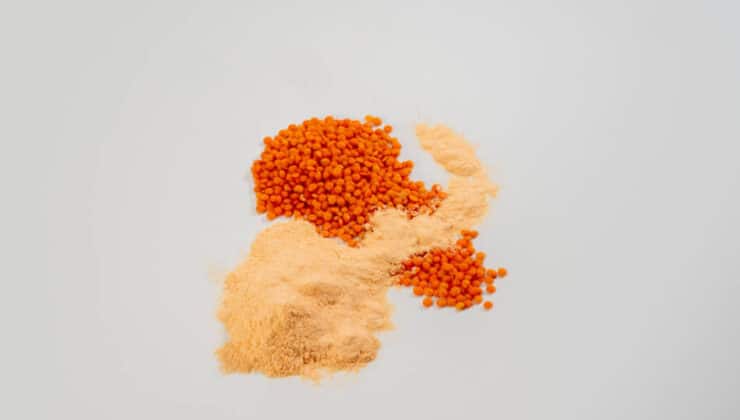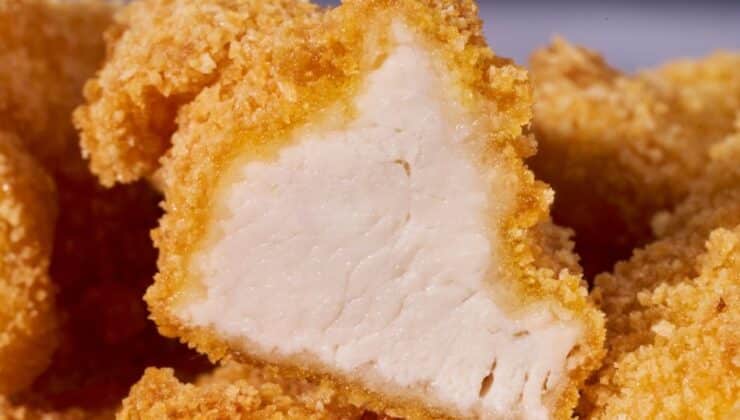Extrusion is a technology used in the food industry that involves applying thermal and mechanical treatment to an ingredient to modify its structure and provide it with new functionalities. This process enables the transformation of raw materials into ingredients with enhanced properties, such as greater stability, an airy and crispy texture, and a high capacity for water interaction. Depending on the process conditions, a product with different shapes, sizes, densities, and textures can be obtained, making extrusion technology a key tool in the production of various foods.
It plays a crucial role in obtaining ingredients such as crispy textured proteins, grits, and heat-treated flours, which are essential in the formulation of many food products.
Texturized Vegetable Protein (TVP)
Extrusion in the plant-based sector enables the production of ingredients with characteristics like animal protein, such as Texturized Vegetable Protein (TVP). This ingredient is widely used in the creation of meat analogues due to its ability to mimic the fibrous texture and structure of animal protein, as well as its protein content.
TVP is produced through an extrusion process in which a protein, such as pea protein, undergoes thermal and mechanical treatment, creating expanded and porous structures. It is available in various particle sizes, offering versatility in food formulation:
- Enhances Protein Content: Significantly increases protein levels in food formulations, meeting the growing demand for high-protein products.
- Clean Label: A product made from pea protein as the sole ingredient, meeting the expectations of health-conscious consumers.
Applications in Various Sectors
The versatility of this texturized protein allows it to be used in multiple industries and food types:
- High-Protein Breads: Enhances the nutritional content of bread and baked goods, addressing the demand for healthier options.
- Meat Products: An efficient solution for use in meat products, such as burgers or sausages, reducing meat content without compromising protein levels and maintaining the original texture.
- Protein Snacks: Ideal for creating innovative, protein-rich snacks, such as energy bars or biscuits.
- Plant-Based Alternatives: A key ingredient in the development of meat substitutes with texture and properties similar to conventional meat products.
- Sports Nutrition: Its high protein content makes it ideal for formulations aimed at supporting performance and muscle recovery.
Extrusion in the Production of Texturized, Crispy Ingredients and Grits
Extruded products, such as texturized ingredients, crisps, and grits, add value to the final product due to their characteristics. Extrusion technology enables the creation of light, airy structures with a crispy texture, enhancing the sensory experience in applications such as coatings or toppings, while also improving technological functionality by facilitating product interaction with water.

The process involves applying heat and mechanical force to a base mixture composed of flours or blends of cereals and legumes, shaping it into a specific form and texture. Depending on the processing conditions, products with varying textures, sizes, shapes, and colours can be obtained. Additionally, extrusion facilitates the incorporation of functional ingredients such as oil, sugars, fibres, or colourants, enhancing their functionality in the final product.

Heat-Treated Flours: Pregelatinized, Precooked, and Stabilised
Another area where extrusion has a significant impact is in the production of heat-treated flours. Depending on the level of treatment, different types can be found:
- Stabilised Flours: In this process, extrusion does not modify the starch structure. The stabilisation process reduces microbial load and inactivates certain enzymes, such as lipases, which are responsible for the rancidity of wholemeal flours, thereby extending their shelf life.
- Precooked Flours: This treatment is at an intermediate level—although the starch is modified, it does not fully affect all granules present in the flour. Extrusion allows the flour to dissolve easily in cold water, increasing the viscosity of the mixture without requiring cooking.
- Pregelatinized Flours: These flours undergo an extrusion process that gelatinises nearly all the starch present. As a result, their capacity to interact with water is much greater than that of precooked flours, making them highly functional for use in a wide range of food applications.

Industrial Applications and Benefits of Extrusion
The advantages of extrusion in the production of these ingredients include:
- Improved texture and functionality in final products.
- Greater stability and shelf life due to the elimination of microorganisms and enzymes that can affect product quality.
- Versatility in formulations, enabling the creation of innovative products with enhanced organoleptic and nutritional profiles.
- Clean label products with technological functionality.
Specialist companies such as Molendum Ingredients, part of the Dacsa Group, utilise extrusion technology to develop tailored solutions for the food industry, ensuring high-quality, functional ingredients.
In summary, extrusion is a key technology in food innovation, allowing the development of versatile products that respond to market trends and consumer demands for quality, nutrition, and sustainability.





